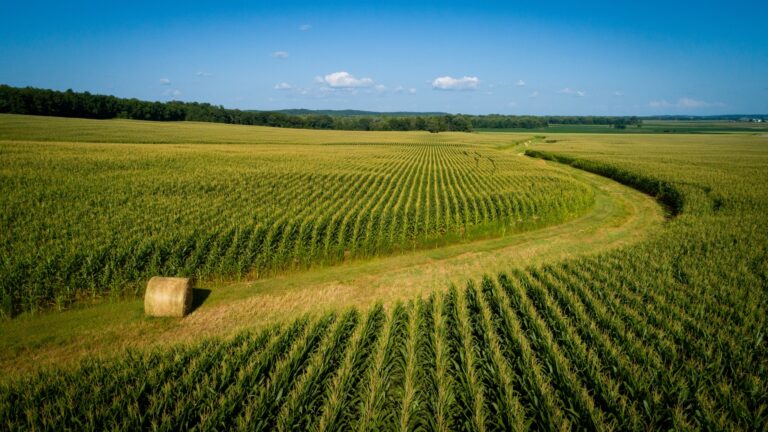2024 July Stewardship Advocate
Iowa State University (ISU) Releases Free Carbon Intensity Score Calculator
There is growing interest in carbon intensity (CI) scores, not only for ethanol plants, but also for corn farmers who grow corn for ethanol fuel. However, there is some uncertainty on how to calculate CI scores, how they can be used and what factors go into calculating scores. This Stewardship Advocate describes a CI calculator recently developed by ISU Extension and Outreach that is posted on the ISU Ag Decision Maker website here. The calculator is meant for informational and educational purposes only and produces estimates of CI scores.
Farmers can use the ISU calculator to estimate their CI score for their current farming practices and then change the responses to see how their score changes with the new inputs and practices. There are just eight inputs needed with this calculator to compute an estimated CI score, including:
- State
- County
- Corn acres (for a field or farm)
- Cover crops (yes or no)
- Manure (yes or no)
- Tillage type
- Pounds of nitrogen per acre
- Yield in bushels per acre
The input page shown below in Figure 1 is a screenshot of the calculator for a fictional 80-acre cornfield in Audubon County Iowa. Entering the eight responses on the left side of the page will generate a CI score for the current state of the operation. On the right side of the page, the farmer can modify any of the inputs to see how the score changes. In the example in Figure 1, the new farming practices include planting cover crops, applying manure, reducing the nitrogen rate by 10 pounds per acre and decreasing the yield by five bushels per acre.
 |
Once the inputs are entered into sections 1 and 2, the calculator produces two estimated CI scores in Section 3. Table 1 below shows the CI scores for both current and new farming practices on a per bushel basis in the form of gCO2e/bushel, where gCO2e stands for grams of carbon dioxide equivalent emissions. The CI scores in Table 2 below are more familiar to farmers where the units are gCO2e/MJ and represents the grams of carbon dioxide equivalent emissions per megajoule of energy in ethanol fuel.
 |
 |
Table 2 shows that adding manure and cover crops reduces (improves) the CI score of the new farming practices to 6.9, a reduction of 23.7 from the 30.6 CI score for the current farming system.
Section 4 of the ISU calculator estimates the maximum 45Z tax credit based on the CI score and on whether the tax credit is the basic or bonus tax credit. 45Z tax credits are awarded to fuel producers (e.g. ethanol plants) who produce “clean fuel” which is defined as fuel produced with no more than 50 kilograms of carbon dioxide equivalent per 1 million British Thermal Units (BTU).
Section 5 then plots the maximum revenue for a farmer based on their CI score and on what percentage of the tax credit the ethanol plant passes on to the farmer (from 0-100%).
The ISU CI calculator includes an important assumption that differs from other CI calculators in that there are fewer inputs in this calculator than many others. In the ISU calculator, the values for other farm inputs (such as phosphorus and potassium fertilizer rates, diesel fuel, herbicides, etc.) were held constant at average county levels so farmers can see the effects of changing just four practices (cover crops, manure, tillage and nitrogen rates) in their county on their CI score. Because of this assumption, CI scores from other companies may be different than from the ISU calculator.
Disclaimer from ISU: The federal government is finalizing the rules and models that will be used in the implementation of the 45Z tax credit, and the final model could differ substantially from the one used in this CI score calculator. The value of this tool is purely educational and does not imply any warranties on the potential payments from the 45Z tax credit program.
Authors and devolopers of the ISU calculator: Alejandro Plastina and Haeun Jo (ISU Extension and Outreach). For more information: Alejandro Plastina, extension economist, 515-294-6160, plastina@iastate.edu.
Latest Information:
5 Reasons Fertilizer Prices Are High Right Now
The pipe is filling – Drainage Contractor
Iowa Learning Farms Webinar – July 10, 2024
Secretary Naig Anticipates Record Year for Progress on Water Quality Wetlands within Iowa
Farmer to Farmer: Aarika Schwarck

Aarika Schwarck and her family farm just south of Riceville, IA in Mitchell County. She and her husband Tony have farmed with his family for the last 10 years. The farm has been in Tony’s family for three generations. Their operation has a lot of moving parts…they raise corn, soybeans and occasionally oats and hay, have a cow-calf operation and feedlot where they finish cattle.
Family and legacy are important to Aarika and having her children in the operation is instinctive since she was raised in agriculture. Aarika says, “I have been in agriculture all my life. As a kid, I helped with my Dad’s livestock operation. Now I play an active role in our row crop and livestock farming operation. We have two children who tag along in all aspects of our farming operations. They are with us working cattle, planting and harvesting the crops and learning the ropes and love for the land and livestock.”
The Schwarck’s vary their corn planting populations based on the soil type of the field. They live in an area where the soil types vary greatly, so they have to plan their seeding rates field by field. She says, “We plant fuller season corn hybrids to utilize for fermented feed in the feedlot. We also grow shorter season hybrids for grain harvest to sell to local ethanol plants. We utilize the cattle manure on our farms to provide necessary nutrients to the crops. We use a nitrogen stabilizer with the manure to protect against nitrate losses.”
Aarika is always in learning mode when it comes to their operation and realizes every growing season is a unique experience. Regarding the 2023 growing season, she recalls, “Due to lack of rain, everyone was worried the yields would be greatly affected because we had little to no rainfall all summer long. Surprisingly, due to the genetics of crops now, yields were a bit lower than normal but even with the little bit of rainfall we had all year, the yields were pretty good. Every year, we try to take what we learned from the previous season and make a few tweaks in the current season. As a farmer, I have to be a life-long learner because I need to be knowledgeable about the latest technologies and we are always looking for ways to improve our operation.”
Aarika’s philosophy on farming is rooted in family, stewardship and animal husbandry. When asking about what she wants other farmers to know about the way they farm, she says, “Coming from a multi-generational farming operation, we truly care about the land, animals and the people we work with. Having two young kids who are actively involved with our farming and livestock operation, we hope to teach them that hard work pays off and that no one cares about your land and livestock more than you. If something needs to be done, do the work and get it done because in the end you’ll be grateful you did it even if it’s hard and challenging.”
In addition to her busy family and farm life, Aarika is an active member of the Iowa Corn Growers Association. She currently serves as the ICGA District 2 Director representing and a member of the Grassroots Network, Membership and Checkoff Committee. She is also a member of the Iowa Cattlemen’s Association, Iowa Soybean Association and an FFA Alumni.
Upcoming Events:
August: Programs and events throughout August at multiple locations; ISU Extension Calendar of Events – Events List (iastate.edu)
August: Practical Farmers of Iowa fields days throughout August at multiple locations; 2024 Field Day Schedule – Practical Farmers of Iowa
August 3: Boone River Cleanup; Webster City, IA
August 14: Coalition to Support Iowa’s Farmers 20th Anniversary Celebration; Iowa State Fairgrounds
August 20-22: Iowa Drainage School to Teach about Farmland Drainage Systems; Nashua, IA
August 27: Cover Crop Field Day – Iowa Learning Farms; Bill Hammitt’s Farm, 3620 240th Street, Portsmouth, IA
